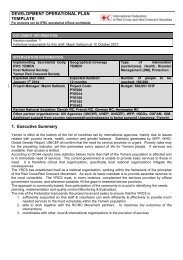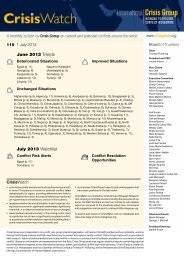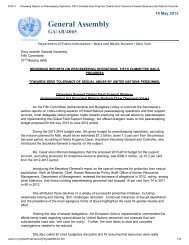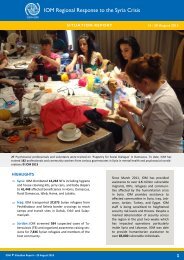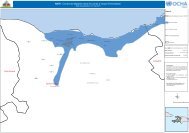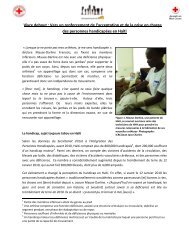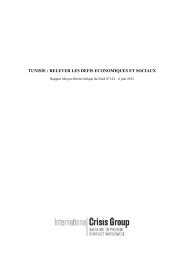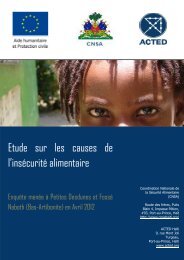SOMALI NUTRITION STRATEGY 2011 – 2013 - ReliefWeb
SOMALI NUTRITION STRATEGY 2011 – 2013 - ReliefWeb
SOMALI NUTRITION STRATEGY 2011 – 2013 - ReliefWeb
Create successful ePaper yourself
Turn your PDF publications into a flip-book with our unique Google optimized e-Paper software.
54<br />
4.4 Management of moderate acute malnutrition<br />
Targeted supplementary feeding programmes (SFPs) for the treatment of moderately malnourished<br />
under-fives and pregnant and lactating women are being implemented by WFP through around<br />
40 local and international NGOs. The current caseload is around 70,000 beneficiaries, of whom<br />
approximately 80% are under-fives and 20% pregnant and lactating women. 50,000 beneficiaries<br />
are being treated with corn soya blend (CSB), fortified vegetable oil, and sugar. In a pilot<br />
intervention, 20,000 are to receive ready-to-use supplementary food (supplementary plumpy)<br />
in Bakool, Bay, and Benadir regions of South Central Somalia, and in Puntland and Somaliland.<br />
In addition, WFP is providing a ‘protection’ ration for families of moderately malnourished under<br />
-fives. This currently provides around 60% of the energy needs of the family.<br />
4.5 Prevention of moderate acute malnutrition <strong>–</strong> food based interventions<br />
In selected sites in Puntland and Somaliland, WFP is providing fortified supplementary food to all<br />
children under-two and pregnant and lactating women through UNICEF supported MCH clinics.<br />
Currently 35 clinics are supported.<br />
As a new initiative, during 2009 UNICEF launched a pilot intervention for the prevention of<br />
malnutrition targeting 100,000 children aged 6-36 months blanket distribution of ready-to-use<br />
food (Plumpy Doz) every two months in areas showing the highest malnutrition rates, with a<br />
particular focus on the Central and South Somalia, in Middle and Lower Shabelle and IDP camps<br />
in the north and poor urban areas.<br />
From May to August 2009, WFP launched and completed an emergency blanket supplementary<br />
feeding covering 135,000 children aged 6-59 months in Galgadud and Mudug regions of Central<br />
Somalia as well as South Nugal in Puntland. This intervention was designed to prevent and treat<br />
moderate malnutrition in areas where very critical rates of malnutrition were recorded (GAM>20%)<br />
with very limited access to nutrition services.<br />
4.6 Institutional Feeding & School Feeding<br />
WFP is providing nutritional support to<br />
other vulnerable groups including HIV<br />
positive and TB cases, orphans, the<br />
mentally handicapped, and hospitalized<br />
patients either as a take home ration<br />
or as daily meals for in patients. This<br />
intervention currently supports 60,000<br />
people including the family protection<br />
ration.<br />
Around 90,000 school children provided<br />
with meals at school from fortified foods.<br />
Girls receive a take home ration of fortified<br />
oil to encourage attendance.<br />
School feeding, WFP Khalif<br />
4.7 General food distribution<br />
WFP is providing food assistance to the rural population affected by the humanitarian crisis, the<br />
urban poor and IDPs with general food ration consisting of cereals, CSB, sugar, fortified oil and<br />
iodised salt when available. In 2009 WFP reached 3.3 million people a month on the basis of<br />
FSNAU seasonal assessments.




